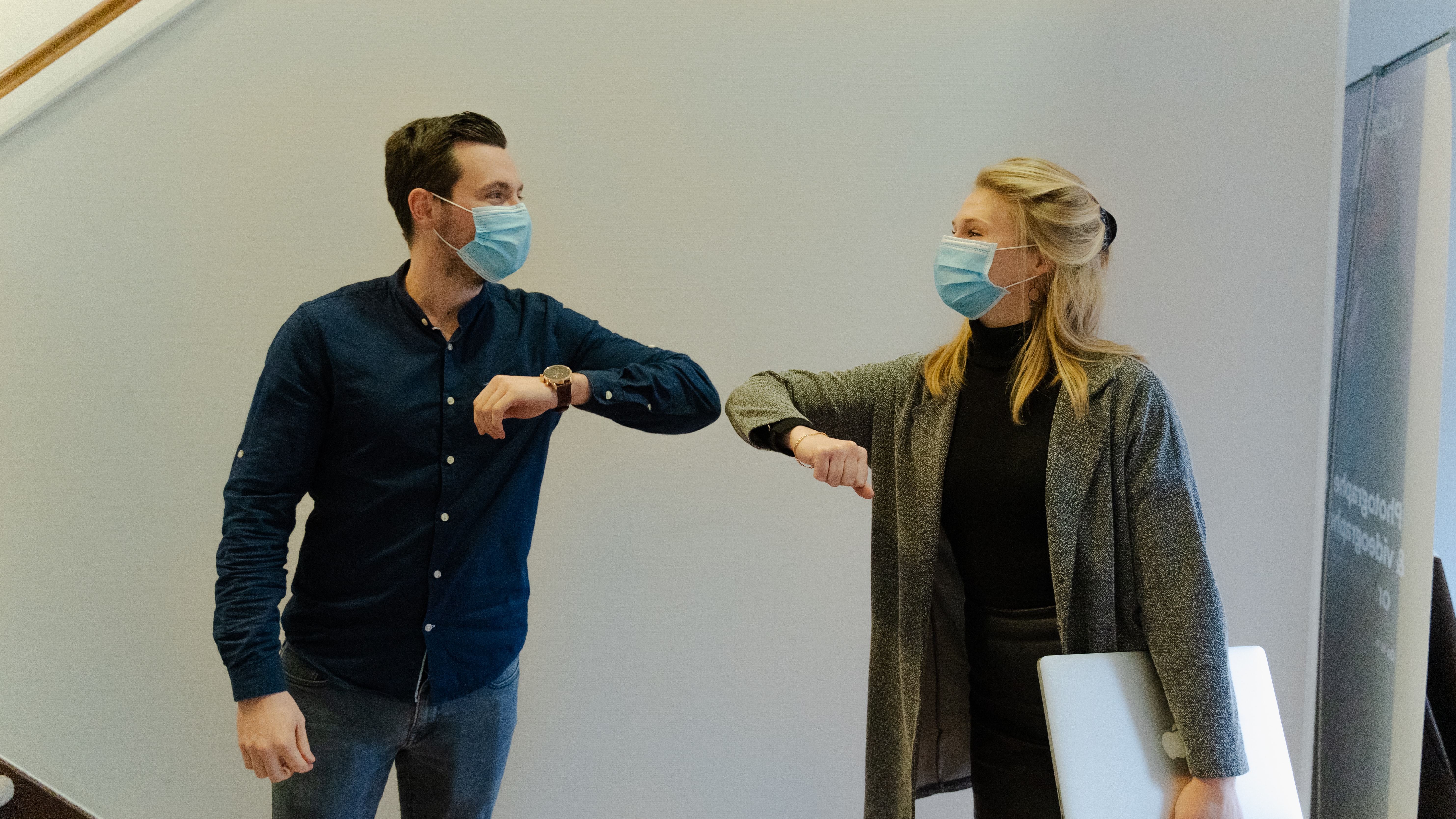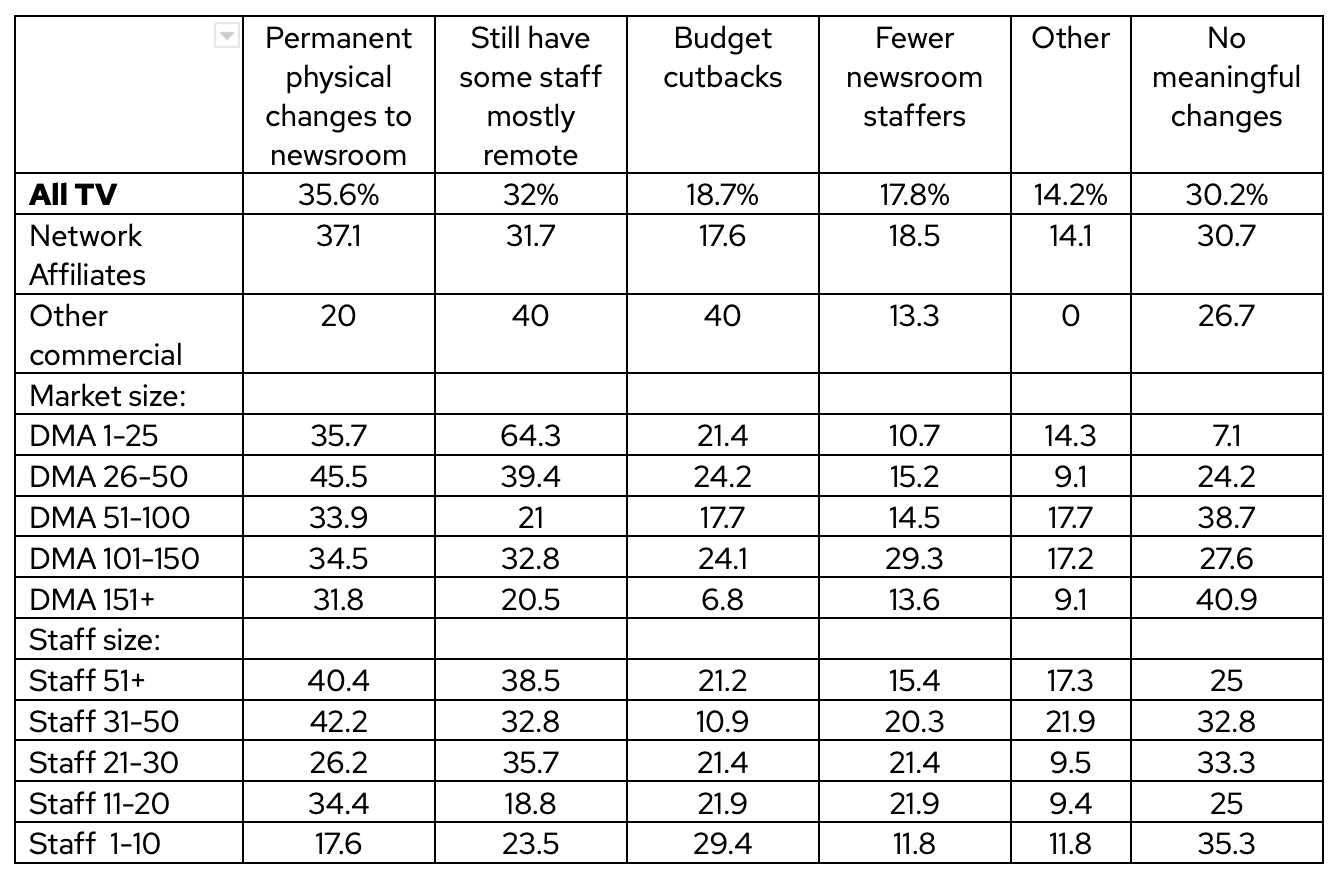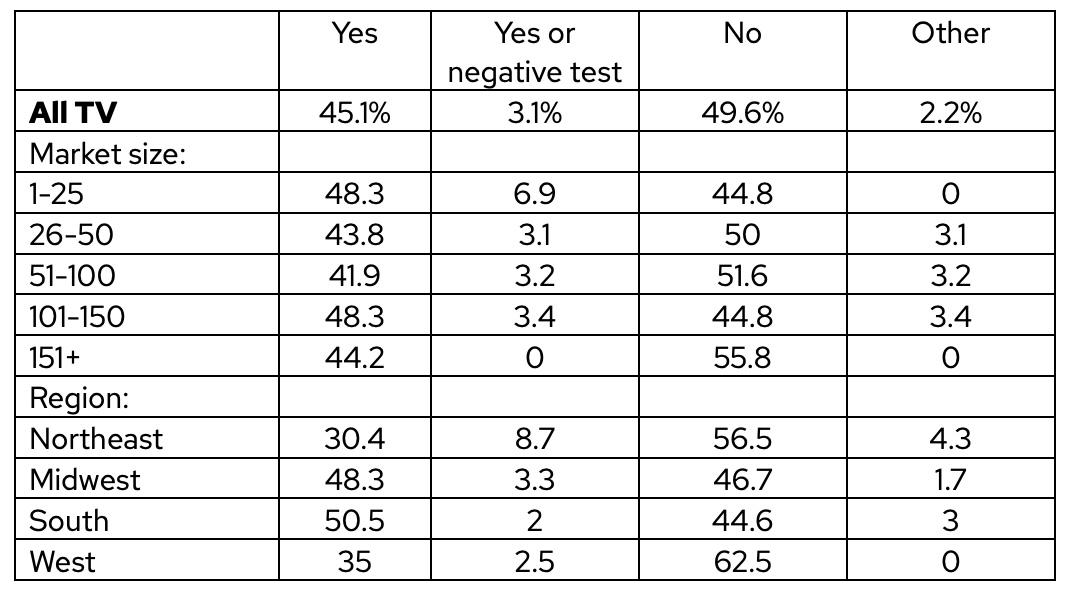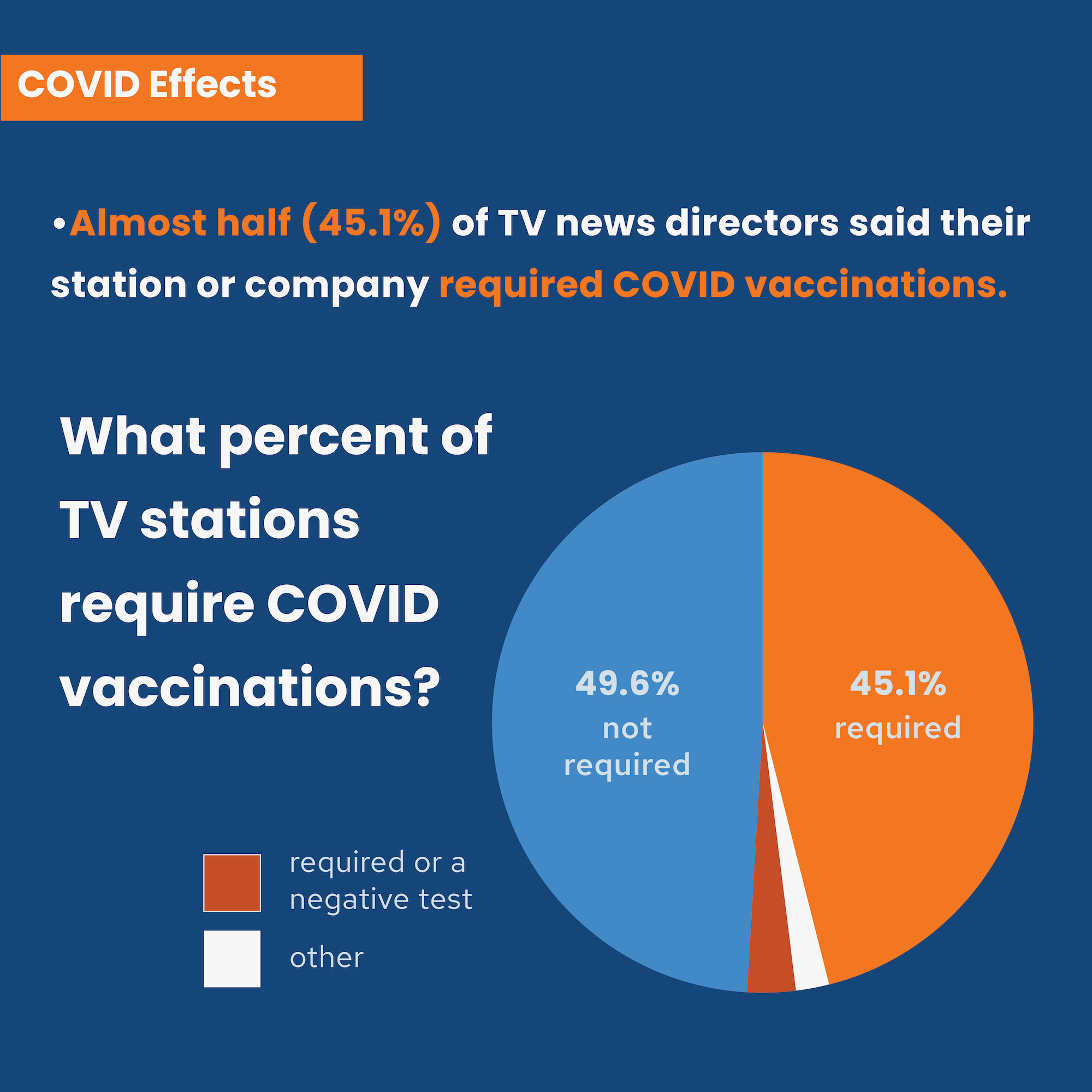COVID Recovery is Slow for the Broadcast News Industry

More than two-thirds of TV news directors say their newsrooms are still experiencing significant impacts of COVID, whether in permanent changes to their newsroom, budget cuts, staff size or remote work.

Just 30% of TV news directors say that coronavirus is not having a major impact on their newsrooms anymore. Still, what a difference a year (or so) makes; that’s up from 6.2% a year ago. More than a third of TV newsrooms have seen permanent physical changes to deal with COVID, and nearly a third still have at least some staff working mostly remotely. Almost 19% have had (or have) budget cutbacks, and nearly 18% have fewer newsroom staffers — down from more than 27% a year ago.


Generally, the bigger the market and the bigger the staff, the more likely that the newsroom is still feeling the effects of COVID. It’s not a completely straight line, but note that just 7.1% of newsrooms in top 25 markets say they’ve made no meaningful changes while 40.9% of stations in markets 151+ say the same thing. There were no meaningful differences by network affiliation, but there were big differences by region. Stations in the Midwest and the South were more than twice as likely to say they’ve seen no meaningful changes.
“Other” is a surprisingly large category, but the answers to “other” are pretty familiar. A third said news people are still wearing masks. A quarter mentioned remote working or hybrid scheduling. Fourteen percent noted virtual meetings instead of in person, and 10% noted “the great resignation” or the difficulties of hiring people.
A majority of TV news directors (55.7%) said they expect long-term changes in how they operate because of the coronavirus. The bigger the market and the bigger the staff, generally the more likely there is an expectation of long-term changes. Network affiliation made no difference, and, interestingly, neither did geography.

Overwhelmingly, TV newsrooms have changed procedures in order to protect staff from COVID. Overall, 92.9% say they’ve made changes. All market sizes are above 90% except the smallest (151+). The bigger the staff, the more likely that the newsroom has made changes. In fact, every newsroom with 51+ staffers has made changes.
At the top of the list, nearly half the newsrooms (46.2%) have mandated social distancing. That includes remote working, virtual meetings, crews riding separately, social distancing in the station, setting up physical barriers or plexiglass, and not allowing visitors to the station.
More than a quarter (26.6%) have mandated masks in the station.
More than one in five (20.6%) require vaccinations, require vaccinations for any visitors, mandate daily or regular testing or health assessments of the staff or require quarantining for any illness.
Six percent (6.1%) do special cleaning or operate air purifiers.
What they’re doing:
- One station has used 6-foot microphone poles
- Several stations have required masks
- Many stations have increased the use of web conferencing, even when employees are in the office
- At one station, anchors are seated farther apart on camera; at another, anchors are never on set together
- In one newsroom, staffers are spread out in the building and no longer confined to just the newsroom
- One station has limited the coverage of large protests
- One news director said employees no longer can share equipment
- Producers and directors sit in separate control rooms at one station
- Several stations say they require visitors show proof of vaccination; others say they no longer allow visitors
- Multiple stations say they do not allow field crews into the building anymore
- Several newsrooms have implemented plastic or plexiglass partitions; one station has installed them in company vehicles
- For one station, no more potluck meals
Almost half (45.1%) of TV news directors said their station or company required COVID vaccinations.


There were not big differences by market size. The smallest newsrooms (1 to 10 staffers) and other commercial stations were noticeably less likely to require vaccinations. So were FOX-affiliated stations. Perhaps counter-intuitively, stations in the South and Midwest were more likely to require vaccinations than stations in the West or Northeast.
“Other” was a mixture of highly recommend vaccinations, vaccinations required of new employees only and “not required but everyone is vaccinated.”
Coronavirus Has Killed Some Local Radio News
The latest RTDNA/Newhouse School at Syracuse University Survey found that, overall, 8.2% of radio stations reported that the coronavirus and the economic disruption it caused led to canceling local news. That’s just a hair higher than the 8% reported a year ago.
The carnage hit across all kinds and sizes of radio stations … in all market sizes, in all regions.
Non-commercial stations were hit a lot harder than commercial ones this year; major and large markets harder than medium and small; stations in the West harder than other regions.
These are all changes from a year ago, but the biggest difference is how hard the virus hit non-commercial stations.
Has the coronavirus/economic disruption led to canceling local news?

The percentage of commercial stations saying that COVID had led to canceling news actually dropped from 7.5% last year to 4.9% this time around. But the percentage of non-commercial stations saying that news had been canceled soared from 9.5% a year ago to 16.9% this time around.
Does your radio station/company require COVID vaccinations?

Stations in major markets and non-commercial stations were more likely to require COVID vaccinations or negative test results. Not surprisingly, the South and Midwest were much less likely to require vaccinations than the West or Northeast.
What about “other?” Half the other said vaccinations were not required, but everyone had gotten vaccinations, and a couple more said vaccinations were required to go to the station; otherwise, people could work from home only. A couple said required vaccinations would violate state law.
Just over 70% of radio news directors and general managers reported that they have changed procedures in order to protect employees from COVID. The bigger the market, non-commercial stations and stations in the West and Northeast were most likely to have done something to protect employees.
Station procedures to protect against COVID:
- 28% Masks
- 22% Extra/special cleaning
- 14% Employees working or mostly working remotely
- 13% Social distancing
- 7% Limited to no guests at the station
- 6% Physical changes like barriers, plexiglass
- 4% Required vaccinations
- 2% Follow CDC, state or local guidelines
- 2% COVID questionnaires/temperature checks
- 2% Regular testing
- 1% Encourage/volunteer vaccinations
How is the coronavirus affecting your radio newsroom today?

More than half (57.7%) of radio news directors and general managers say that things are “pretty much back to normal” at their stations. That’s a 16-point increase from a year ago. Note that the response ties in directly to market size and commercial versus non-commercial.
Two-thirds of radio news directors and general managers expect to see no meaningful long-term changes. Again, the numbers broke down based on market size and commercial versus non-commercial.
What long-term changes do you expect because of COVID?
Beyond the current effects, we asked about long-term changes that news directors and general managers expected because of COVID. At the top of the list, at 61%, came remote work, including working from home, hybrid schedules, virtual meetings instead of in-person and remote interviewing.
Next, at 27%, again came the extension of current practices: cleaning, social distancing and the use of masks.
6% noted greater awareness of public health rules and recommendations, health screenings and required vaccinations.
4% said long-term effects included fewer news people and learning to live with reduced advertising/income.
2% noted technology: better remote technology and different handling of technology, like personal mics or windscreens.
Bob Papper is Adjunct Professor of Broadcast and Digital Journalism at Syracuse University and has worked extensively in radio and TV news.
Keren Henderson is Associate Professor of Broadcast and Digital Journalism at Syracuse University. This research was supported by the S. I. Newhouse School of Public Communications at Syracuse University and the Radio Television Digital News Association.
About the Survey
The RTDNA/Newhouse School at Syracuse University Survey was conducted in the fourth quarter of 2021 among all 1,780 operating, non-satellite television stations and a random sample of 3,379 radio stations. Valid responses came from as many as 1,336 television stations (75.1%) and 765 radio news directors and general managers representing 2,310 radio stations. Some data sets (e.g. the number of TV stations originating local news, getting it from others and women TV news directors) are based on a complete census and are not projected from a smaller sample.
